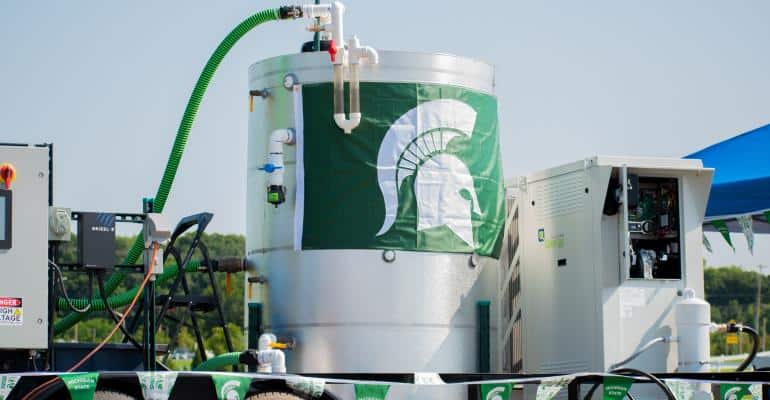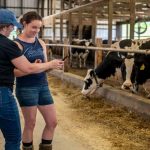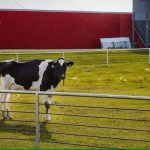
One of the next climate change solutions might be found at your local dairy farm. A team of MSU researchers is studying ways to generate renewable energy from dairy farm waste to charge electric vehicles (EVs).
Wei Liao, a professor in MSU’s Department of Biosystems and Agricultural Engineering (BAE) and the director of MSU’s Anaerobic Digestion Research and Education Center (ADREC), recently led a demonstration workshop showcasing the novel research linking dairy operations to the auto industry. He was joined by MSU animal science professor Barry Bradford, BAE professor Ajit Srivastava, dairy farm manager Jim Good and BAE research specialist and ADREC manager Sibel Uludag-Demirer.
An electric tractor designed by Srivastava was showcased for its ability to operate on renewable electricity generated by a mobile renewable EV charging station with an anaerobic digester and an external combustion engine. Anaerobic digestion is the biological process where organic matter, like animal and food waste, is broken down in the absence of oxygen to produce biogas. The biogas can be burned to generate electricity and heat, or cleaned and used as renewable natural gas.
Although economic pressures have prompted part of the U.S. dairy industry to consolidate into large scale productions, the majority — 90% — still operate at small and medium-sized enterprises of less than 1,000 cows.
Dairy is the leading agricultural commodity in Michigan. The industry accounts for nearly 5% of the state’s gross domestic product with $24 billion generated annually and supports over 111,000 jobs.
Liao said his hope is to implement mobile EV charging units on small and medium-sized dairy farms as the state continues shifting toward EV production to reduce carbon emissions from gasoline-powered vehicles. He wants to give farmers in rural communities a way not only to charge their own EVs, but also to generate revenue doing it for other’s vehicles.
“We want to use this opportunity to link together the agriculture and auto industry,” Liao said. “They can both benefit from each other.”
Another reason Liao would like to introduce EV units on farms is to help encourage the dairy industry to become carbon neutral or have net zero carbon emissions. He said currently about 45% of the carbon in animal feed ends up in manure and is partially released as methane – a greenhouse gas (if not collected) — into the atmosphere.
If farmers can use the waste for high-value applications, like producing electricity and charging EVs, he said part of the climate problem becomes part of the solution.
“That’s just a win-win,” Liao said. “We can achieve the carbon neutrality of dairy farms and can similarly reduce emissions for the transportation sector.”
MSU converts food and animal organic waste from campus at its South Campus Anaerobic Digester (SCAD). The digester, an above-ground steel tank capable of holding 450,000 gallons, has been in operation since 2013 and has digested roughly 60,000 tons of manure. In 2022, it digested 12,500 tons of manure from the MSU dairy farm and 15,000 tons of food waste from MSU’s cafeterias and the greater Lansing region.
The digester produces about 2.8 million kWh of electricity per year. Ten percent of that energy powers the digester itself, and the rest assists in powering 10 buildings across MSU’s south campus.
The mobile units Liao is working toward installing on small and medium-sized dairy farms won’t be as big and won’t be able to initiate the same amount of power as the SCAD. He said they’ll have the capacity to induce 30 kWh of renewable energy per day, or over 10,950 kWh of energy per year.
While that figure won’t be enough power to run an entire farm, Bradford said it could grant farmers different operational opportunities. For example, the energy from these units could charge batteries of emerging electric skid-steer loaders, or small low-power tractors used to clean animal pens.
“If you could charge (these tractors) yourself without paying a lot and having to deal with how you’re going to charge them, that could potentially be a game changer for how jobs are done on dairy farms,” said Bradford, whose role on the project is to understand how these units will impact dairy farms.
He also said electric charging stations on dairy farms could bring additional economic opportunities. As EVs become more popular and people look for places to charge them, dairy farms could become a viable option that allow visitors to charge their cars while also experiencing the work of local farms.
“Because it takes a little while to charge EVs, longer than it does to fill a tank of gas, farms can keep visitors occupied by selling them a sandwich or an ice cream cone. Maybe they can do a $5 tour of the farm,” Bradford said. “This could be a more mixed funding model where you have agritourism, energy and — of course — milk.”
Funding for the projects comes from MSU AgBioResearch, along with the Michigan Economic Development Corporation, MSU Extension and the U.S. Department of Agriculture’s (USDA) Agriculture Research Service.

























